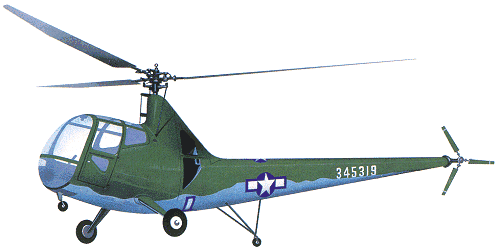
| Sikorsky R-6 1943 |  |
 |

| Sikorsky R-6 1943 |  |
 |
|
Ordered in 1943, the Sikorsky XR-6 prototype (43-47955) made its maiden flight on 15 October 1943. As its manufacturer's designation indicated, it was essentially a refined and developed version of the R-4, and the same rotor and transmission system was used in both types. A 225hp Lycoming O-435-7 engine provided the power, and the fuselage was transformed into a highly streamlined, metal-skinned unit with a one-piece moulded plexiglas cabin for the 2 crew members. On a March 1944 the XR-6 set new helicopter distance, endurance and altitude records when it made a non-stop flight of 623km from Washington, D.C, to Dayton, Ohio, in 4 hr. 55 min, climbing to 1524m over the Allegheny Mountains en route. The XR-6 was followed by five 2-seat service test XR-6A's for the USAAF and U.S. Navy, built by Sikorsky with 240hp Franklin O-405-9 engines, and twenty-six generally similar pre-production YR-6A's built by the Nash-Kelvinator Corporation. The latter company also carried out the production of the one hundred and ninety-three R-6A's built from 1945. Thirty-six of these were delivered to the U.S. Navy as the HOS-1, and formed the equipment of that service's first helicopter squadron, which commissioned in July 1946. Forty R-6A's were supplied to Britain under Lend-Lease, these being named Hoverfly II in British service. Fifteen of them were allocated to the Fleet Air Arm for communications and training in 1946; others served with No.657 (AOP) Squadron RAF and the Airborne Forces Experimental Establishment. Like the R-4, the R-6 could be fitted with pontoons as an alternative to a wheeled landing gear, and was employed on a variety of duties including air/sea rescue, casualty evacuation and observation. Its career was, however, a short one: it was frequently beset by engine difficulties, and soon gave way to the more reliable R-5 and its derivatives. A proposed Lycoming-powered R-6B version by Nash-Kelvinator was cancelled. K.Munson "Helicopters And Other Rotorcraft Since 1907", 1968  The R-4's rotor and transmission system was installed in a new streamlined fuselage with an all-metal semi-monocoque tail boom to become the VS-316B or XR-6, powered by a 168kW Avco Lycoming O-435 engine. Some 193 production helicopters were built for the USAAF as the R-6A, for the US Navy as the HOS-1 and for the British as the Hoverfly Mk II. D.Donald "The Complete Encyclopedia of World Aircraft", 1997
|